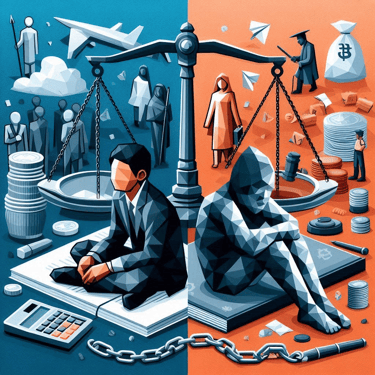Introduction
The Indian legal system treats juveniles and adults differently due to their distinct developmental stages and capacities for reform. The Juvenile Justice System aims to rehabilitate and reintegrate young offenders into society, while the Adult Criminal Justice System focuses on deterrence and punishment. Understanding these differences is crucial for legal professionals and policymakers to ensure a fair and effective justice system. Many historical cases show how a juvenile accused is treated differently.
The Juvenile Justice (Care and Protection of Children)[1] Act, 2015, governs the handling of juveniles in conflict with the law in India. This act aims to provide juveniles with care, protection, and treatment, emphasizing their rehabilitation and social reintegration. The principle of "best interest of the child" is central to the juvenile justice system, focusing on reform rather than punishment.
Adult criminal proceedings in India are governed by the Indian Penal Code[2] (IPC) and the Code of Criminal Procedure[3] (CrPC). The primary objectives are deterrence, retribution, and incapacitation. The process is formal, with strict procedural safeguards to ensure fair trials and just punishment. The emphasis is on protecting society from criminal behaviour through punitive measures.
Provisions
The Juvenile Justice (Care and Protection of Children) Act, 2015 defines a juvenile as an individual below 18 years of age (Section 2(35)). For certain heinous offenses, juveniles aged 16-18 can be tried as adults after a preliminary assessment by the Juvenile Justice Board (Section 15). Whereas in adult criminal proceedings according to the Indian Penal Code (IPC) and the Code of Criminal Procedure (CrPC), an adult is an individual who is 18 years of age or older. The Juvenile Justice Act mandates that juveniles be tried by the Juvenile Justice Board, which comprises a judicial magistrate and two social workers (Section 4). Procedures are child-friendly, and the Juvenile Justice Board must ensure the rights of the child are protected throughout the process (Section 3). Even the child’s identity is not revealed throughout the trial. In adult criminal proceedings punishments include fines, imprisonment, and in some cases, the death penalty as per the IPC. The court considers the nature of the crime and the offender's circumstances when determining the sentence. Juvenile trials are conducted in a non-adversarial, child-friendly manner, with in-camera proceedings to protect the privacy of the juvenile (Section 14). Adult trials are formal, and public, and follow strict procedural rules outlined in the CrPC.
Nirbhaya Rape case
In the Nirbhaya Case (2012)[4], one of the accused was a juvenile. The Juvenile Justice Board sentenced him to three years in a reform home, the maximum punishment under the Juvenile Justice Act. In contrast, the adult offenders received the death penalty. This case highlighted the stark differences in handling juvenile and adult offenders and sparked debates on whether the age of juveniles should be lowered for heinous crimes. Later it was felt that the erstwhile Juvenile Justice Act, 2000 (Old Act) was incapable of dealing with the issues of youth, due to these factors old act was replaced with the new act Juvenile Justice Act 2015 (New Act).
Challenges And Criticism
The juvenile justice system faces challenges such as inadequate infrastructure, lack of trained personnel, and insufficient rehabilitation programs. Critics argue that the system is too lenient on serious offenders, potentially undermining public safety. On the other hand, the adult criminal justice system is criticized for its overcrowded prisons[5], lengthy trial processes, and harsh punishments that may not effectively deter crime.
Reform and Future Perspectives
Recent reforms in the juvenile justice system include the 2015 Act allowing juveniles aged 16-18 to be tried as adults for heinous offenses, based on a preliminary assessment by the JJB. This aims to balance rehabilitation with public safety. In the adult system, there is a growing emphasis on alternative sentencing, prison reforms, and faster trial processes to address systemic inefficiencies.
Conclusion
The juvenile and adult justice systems in India are designed to address the unique needs and circumstances of offenders at different stages of life. While the juvenile system prioritizes rehabilitation and reintegration, the adult system focuses on deterrence and punishment. Both systems have their strengths and weaknesses, and continuous reforms are essential to enhance their effectiveness and fairness. A balanced approach, considering the best interests of society and the individual, is crucial for a just legal framework.
REFERENCES:
[1] Juvenile Justice (Care and Protection of Children) Act, 2015
[2] Indian Penal Code, 1860
[3] Code of Criminal Procedure, 1973
[4] The times of India, Case study of Nirbhaya Rape case (2012) https://timesofindia.indiatimes.com/india/what-is-nirbhaya-case/articleshow/72868430.cms visited on 28/7/2024
[5] The times of India, 66% of state prisons overcrowded by up to 250%; overall staff crunch at 26% https://timesofindia.indiatimes.com/city/bengaluru/66-of-state-prisons-overcrowded-by-up-to-250-overall-staff-crunch-at-26/articleshow/102268213.cms visited on 28/7/2024


